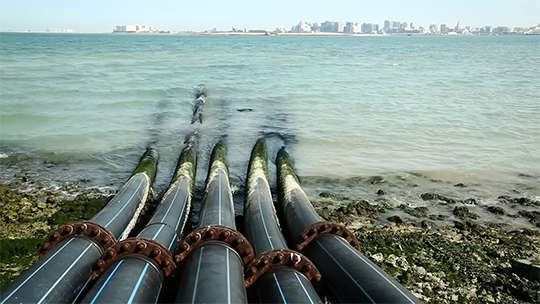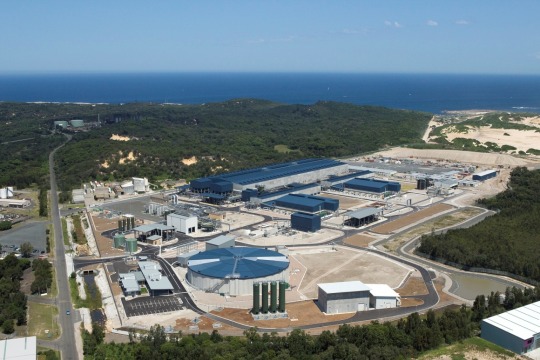#desalinization
Explore tagged Tumblr posts
Text
We seem to have hit on a really good one here, thanks to a collaboration between MIT and Shanghai Jiao Tong University (SJTU). I couldn’t even cram all the benefits of this thing into my diary title.
This device breaks the record for rate of fresh water production from seawater by a solar device, and as awesome as that is, it’s actually kind of a charming side note. The bigger breakthrough is that the device can keep running up near this rate for a long time without getting fouled by salt accumulation, and it does this by emulating natural processes that occur in the sea. That cuts costs by about 10x compared to typical solar desalination, making the cost of the fresh water it produces comparable to that of tap water.
This is real, as legit as MIT and SJTU... which is pretty legit.
One of the onrushing 21st century crises is fresh water, but if we can convert sea water cheaply & efficiently then that particular crisis is solved!
45 notes
·
View notes
Text
Scientists have developed a new solar-powered system to convert saltwater into fresh drinking water which they say could help reduce dangerous the risk of waterborne diseases like cholera.
Via tests in rural communities, they showed that the process is more than 20% cheaper than traditional methods and can be deployed in rural locations around the globe.
Building on existing processes that convert saline groundwater to freshwater, the researchers from King’s College London, in collaboration with MIT and the Helmholtz Institute for Renewable Energy Systems, created a new system that produced consistent levels of water using solar power, and reported it in a paper published recently in Nature Water.
It works through a process called electrodialysis which separates the salt using a set of specialized membranes that channel salt ions into a stream of brine, leaving the water fresh and drinkable. By flexibly adjusting the voltage and the rate at which salt water flowed through the system, the researchers developed a system that adjusts to variable sunshine while not compromising on the amount of fresh drinking water produced.
Using data first gathered in the village of Chelleru near Hyderabad in India, and then recreating these conditions of the village in New Mexico, the team successfully converted up to 10 cubic meters, or several bathtubs worth of fresh drinking water. This was enough for 3,000 people a day with the process continuing to run regardless of variable solar power caused by cloud coverage and rain.
[Note: Not sure what metric they're using to calculate daily water needs here. Presumably this is drinking water only.]
Dr. Wei He from the Department of Engineering at King’s College London believes the new technology could bring massive benefits to rural communities, not only increasing the supply of drinking water but also bringing health benefits.
“By offering a cheap, eco-friendly alternative that can be operated off the grid, our technology enables communities to tap into alternative water sources (such as deep aquifers or saline water) to address water scarcity and contamination in traditional water supplies,” said He.
“This technology can expand water sources available to communities beyond traditional ones and by providing water from uncontaminated saline sources, may help combat water scarcity or unexpected emergencies when conventional water supplies are disrupted, for example like the recent cholera outbreaks in Zambia.”
In the global rural population, 1.6 billion people face water scarcity, many of whom are reliant on stressed reserves of groundwater lying beneath the Earth’s surface.
However, worldwide 56% of groundwater is saline and unsuitable for consumption. This issue is particularly prevalent in India, where 60% of the land harbors undrinkable saline water. Consequently, there is a pressing need for efficient desalination methods to create fresh drinking water cheaply, and at scale.
Traditional desalination technology has relied either on costly batteries in off-grid systems or a grid system to supply the energy necessary to remove salt from the water. In developing countries’ rural areas, however, grid infrastructure can be unreliable and is largely reliant on fossil fuels...
“By removing the need for a grid system entirely and cutting reliance on battery tech by 92%, our system can provide reliable access to safe drinking water, entirely emission-free, onsite, and at a discount of roughly 22% to the people who need it compared to traditional methods,” He said.
The system also has the potential to be used outside of developing areas, particularly in agriculture where climate change is leading to unstable reserves of fresh water for irrigation.
The team plans to scale up the availability of the technology across India through collaboration with local partners. Beyond this, a team from MIT also plans to create a start-up to commercialize and fund the technology.
“While the US and UK have more stable, diversified grids than most countries, they still rely on fossil fuels. By removing fossil fuels from the equation for energy-hungry sectors like agriculture, we can help accelerate the transition to Net Zero,” He said.
-via Good News Network, April 2, 2024
#water#water scarcity#clean water#saline#desalination#off grid#battery technology#solar power#solar energy#fossil fuels#water shortage#india#hyderabad#new mexico#united states#uk#united kingdom#good news#hope#aquifers
1K notes
·
View notes
Text
Water desalination plants could replace expensive chemicals with new carbon cloth electrodes that remove boron from seawater, an important step of turning seawater into safe drinking water. A study describing the new technology has been published in Nature Water by engineers at the University of Michigan and Rice University. Boron is a natural component of seawater that becomes a toxic contaminant in drinking water when it sneaks through conventional filters for removing salts. Seawater's boron levels are around twice as high as the World Health Organization's most lenient limits for safe drinking water, and five to 12 times higher than the tolerance of many agricultural plants.
Read more.
47 notes
·
View notes
Text

Saudi Arabia is the only country without any permanent rivers or lakes. The nation relies on wadis and desalination for its water supply due to its arid climate.
87 notes
·
View notes
Text
#good news#environmentalism#science#clean water#clean drinking water#drinking water#water#mni wiconi#environment#green technology#technology#desalination
59 notes
·
View notes
Text
Desalination in Action

Desalination -- the removal of salt from water -- is an important process for providing the fresh water we need, but it's quite expensive in terms of energy. In this Practical Engineering video, Grady demonstrates small-scale versions of the two most common methods for purifying water: distillation and reverse osmosis. (Video and image credit: Practical Engineering) Read the full article
98 notes
·
View notes
Text
well. research i saw stated by a crank 10 years ago
23 notes
·
View notes
Text

Sydney seawater desalination plant
27 notes
·
View notes
Text
Casey Handmer is at it again
Casey Handmer — who you may recall from his fanfic "the Martian but with Starship" and his NASA-redefining proposal "space science but with Starship" and his Mars terraforming-for-cheap proposal and his carbon-negative carboniferious-fuel company Terraform Industries — now proposes to rehydrate the Salton Sea, refill the Colorado River, and end water shortages in the area with the power of solar energy.
All he needs is seed capital, some bulldozers, an environmental impact statement, and maybe a passport, and he'll be set up to be the water baron of the American Southwest, minting low-cost water from the oceans.
7 notes
·
View notes
Text
tbh I feel like just making zillions of tons of salt bricks from desalination (of inland water sources) would be fine, I think there are salty aquifers around? Ok yeah, there’s loads of brackish aquifer water. Solar to desalinate that is probably an inevitability, since CA farmers have pumping rights.
So, using excess solar energy to desalinate all the way into solids would maybe be plausible, in combo with storing them uhhh… under a tarp somewhere.
3 notes
·
View notes
Text
MYYY BABY MY BABY YOU'RE MY BABY SAY IT TO MEEEEEEE
#24#desalination acting like he won the fight as if klim wasn't the last man standing with blood on his face for defending a teammate#wings lb
6 notes
·
View notes
Text
Fresh drinking water is a vital yet limited resource that will only grow scarcer over the next few years, according to the World Resources Institute. Desalination, the process of removing salt from water, is an established method used to increase the fresh water supply, especially in coastal regions. However, current desalination systems are dependent on large-scale centralized infrastructure and filtration membranes prone to fouling and degradation. A team of Rice University engineers has developed a system that could transform desalination practices, making the process more adaptable, resilient and cheaper. The new system, described in a study published in Nature Water, is designed to be powered by sunlight and uses a creative approach to heat recovery for extended water production -- with and without sunshine. In contrast to conventional systems, the setup is made from nondegradable materials and can handle high-salinity brines.
Read more.
15 notes
·
View notes
Text
i am SO glad that more people are talking about how fanon elain / elain in e/riel is a blatant self-insert proxy
#that’s all i’ve got to say#sorry i’ve been extra salty friends#i was anxious because my family was driving down with all of my stuff bc i just recently moved#but they made it safe!!!#and i will desalinate myself
2 notes
·
View notes
Text
#good news#environmentalism#science#solar energy#clean water#water desalination#salt water#environment#nature#innovation#green technology
38 notes
·
View notes
Link
84 notes
·
View notes
